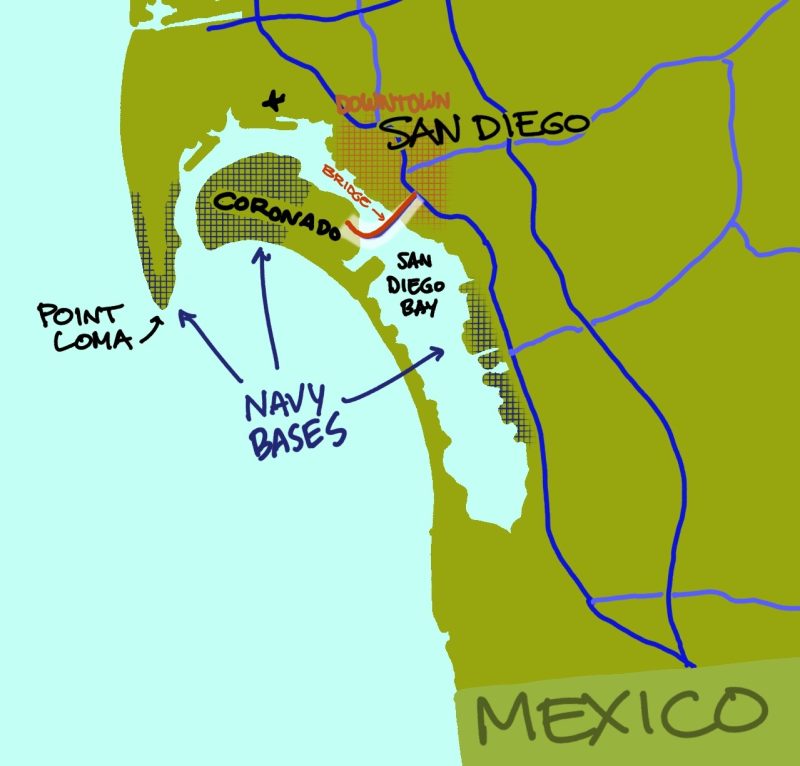I watched video of the Francis Scott Key Bridge falling this morning. It’s horrifying.
There is a connection to The Wire. Season 2 was set at the ports. David Simon, humanist and writer and creator on The Wire, tweeted this:
Thinking first of the people on the bridge. But the mind wanders to a port city strangling. All the people who rely on ships in and out. The auto-ship imports, Domino Sugar, coal exports, dockwork, whatever container traffic we didn’t lose to Norfolk. Industries. Jobs. Families.
The collapse in Baltimore got me thinking about local bridges here in San Diego. And the main one we have is the Coronado Bay Bridge. San Diego is no longer a major port city. We do have some shipping but most cargo comes into the Ports of Los Angeles and Long Beach. I don’t think much San Diego manufacturing, or even Mexican manufacturing, leaves the Port of San Diego. Many fewer lives depend on San Diego’s Coronado Bridge being in place than on the Key Bridge.
I am from San Diego. I grew up here, in increments. As much as I identify with this place I spent only 5 of my first 18 years here. But I heard the folk tale that the Coronado Bay Bridge “floated.” Wikipedia calls it an “urban legend.”
A decades-old local urban legend claims the center span of the bridge was engineered to float in the event of collapse, allowing Naval ships to push the debris and clear the bay. The myth may have developed as a result of the hollow box design of the 1,880-foot center span, combined with the low-profile barges that made it appear to float on its own during construction. However, Caltrans and the bridge’s principal architect, Robert Mosher, maintain that the legend is false.

The bridge itself has an unusual profile. It’s very tall and very high and very thin. So that lends itself to speculation as to why. The other part of the natural speculation is the broad importance of the US Navy to San Diego’s growth owing to Naval Base San Diego. That is, what if 32nd Street is attacked? If a foreign power blew up the bridge how hobbled would the Navy be? And so the answer to “why would it need to float?” would be “because if the Soviets blow it up, we’d have to clear out the debris quickly, so of course when it was designed it was for that purpose. So the logic goes.
There’s a 1982 story from The San Diego Reader: Byrd Thysell, Coronado bridge manager, gives a tour The sky above, the bay below. It mentions that:
A bridge connecting Coronado to San Diego was first proposed in 1926 by the J.D. and A.B. Spreckels Securities Company of San Diego, but Navy opposition (should the bridge collapse, more than one hundred navy ships would be trapped in the southern part of the harbor)
And this:
…Navy opposition began to wane, though as recently as May, 1962 the navy had proclaimed it was against the bridge because “structural failure, sabotage, or disaster” could trap more than 300 vessels, including 120 active-duty ships. IN September the Navy said its worries would end if a second ocean-entry passage were channeled at the South end of the bay. The following month Navy Undersecretary Paul Fay stated that although the Navy would continue its opposition to the bridge, if one were built, the Navy would not curtail its San Diego operations, and if it felt the community really wanted the bridge, all objections would be withdrawn.
And apparently there has been a rumor of explosives planted in the bridge, and also along the strand, to allow naval vessels to leave the bay in the event of catastrophe. Matthew Alice addressed this question in The San Diego Reader on April 13, 1995: Explosives planted in the Coronado bridge: How ships will escape from the bay in case of sabotage. The response is pithy and not full of detail, but those Alice columns always strike me as authoritative:
Most of [Coronado] has been unhappy about the bridge since San Diegans first started discussing it in the mid-1920s.
Even back then, the Navy had real concerns about ships being trapped in the harbor if the bridge were sabotaged. So of course, there’s a contingency plan. Special units of the Navy are trained to clear bridge debris in case of a collapse, and that does include placing explosives in predetermined locations to break up the fallen structure and make it easier to remove. All this was considered during the bridge design, but there’s no dynamite actually built into it.
The 1982 story is a wonder of local and state politics. It also describes that upon opening the bridge the regular ferry service shut down. There are still ferries that run from San Diego to Coronado, but they don’t carry cars. That ferry had been running since the 1880s.
As it is the most important ships the Navy has here in 2024 are aircraft carriers and submarines, and neither category of ship berth in San Diego Bay past the bridge. The carriers berth across the channel from our (civilian) airport. That base is at the northern end of Coronado. And subs berth facing Coronado along Point Loma at the sub base. The 32nd Street base–which I remember as a kid as a bustling base where my grandfather bought ice cream in gigantic cardboard tubs–is less important now than it was then.

Naval Base Coronado describes itself as:
Unequalled in operational scope and complexity, NBC provides a shore-based platform for helicopters, aircraft carriers, SEAL Teams and other ashore and afloat commands for access to a comprehensive quantity of ground, sea, air, and undersea operational and training space. NBC accommodates the requirements of 16 helicopter squadrons, 2 fixed wing squadrons, two aircraft carriers, four SEAL Teams, Navy Expeditionary Combat Command squadrons, and other air, surface and subsurface commands.
Presumably not having to deal with getting hemmed in by debris or needing to blow anything up to exit the bay is part of that mission statement.

four comments so far...
ha! I grew up with that urban legend of explosives under the silver strand. Made sense at the time to my kid brain that the Navy could quickly Macgyver an exit. How hard could an impromptu Panama Canal be?
Love this! I had no idea about the legends and hadn’t really thought about how the Navy might have been opposed to the bridge. Fascinating.
[…] of drawing, I did do a map for No, Bridges Don’t Float and I have some works in progress in paper and in Procreate. But I’ve been […]
[…] Illustration can enrich the feeling of the written word. I made an illustration for my post of Bridges Don’t Float. […]